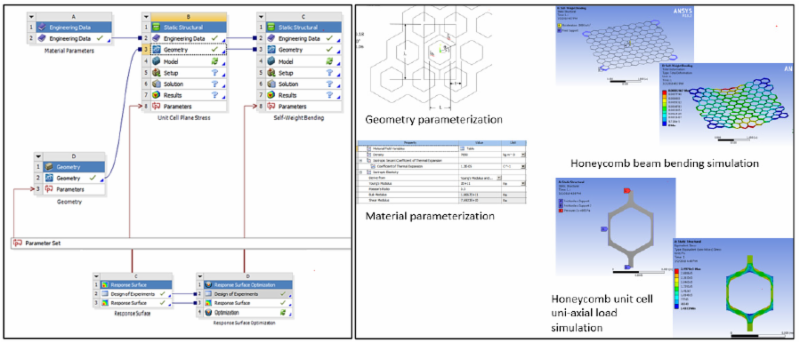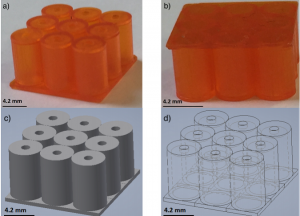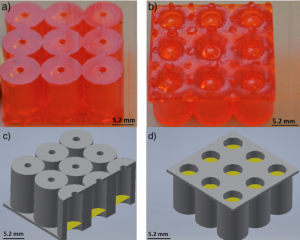Incredibles ROBOT #3DPrinting #3DThursday
Comma_ok shared this project on Thingiverse!
my take on the incredibels robot.
the version you see in the pictures is a bit changed, i decreast the feel size to get better proportions.

Every Thursday is #3dthursday here at Adafruit! The DIY 3D printing community has passion and dedication for making solid objects from digital models. Recently, we have noticed electronics projects integrated with 3D printed enclosures, brackets, and sculptures, so each Thursday we celebrate and highlight these bold pioneers!
Have you considered building a 3D project around an Arduino or other microcontroller? How about printing a bracket to mount your Raspberry Pi to the back of your HD monitor? And don’t forget the countless LED projects that are possible when you are modeling your projects in 3D!
Threads and Bobbins Carousel #3DThursday #3DPrinting
Shared by sarf2k4 on Thingiverse:
Made this for someone to have better access to the sewing threads as well as the bobbins. Don’t have to reach for a container and rummage through them anymore.
It is stackable as much as you want it to be.
Download the files and learn more

Every Thursday is #3dthursday here at Adafruit! The DIY 3D printing community has passion and dedication for making solid objects from digital models. Recently, we have noticed electronics projects integrated with 3D printed enclosures, brackets, and sculptures, so each Thursday we celebrate and highlight these bold pioneers!
Have you considered building a 3D project around an Arduino or other microcontroller? How about printing a bracket to mount your Raspberry Pi to the back of your HD monitor? And don’t forget the countless LED projects that are possible when you are modeling your projects in 3D!
The Adafruit Learning System has dozens of great tools to get you well on your way to creating incredible works of engineering, interactive art, and design with your 3D printer! If you’ve made a cool project that combines 3D printing and electronics, be sure to let us know, and we’ll feature it here!
Open Source Laboratory Rocker / Mixer / Shaker (Lab Rocker) #3DPrinting #3DThursday
akshay_d21 shared this project on Thingiverse!
Here is my take on the laboratory rocker, which is a laboratory tool/device used in laboratories for mild to moderately aggressive biological and molecular mixing applications.
→ This variable speed, 2-dimensional rocker was completely designed in Autodesk Fusion360.
→ The design utilizes a changeable apparatus rack/tray/platform for holding apparatus to perform a see-saw motion for mixing content.
→ The rack/tray can be secure in place using the side locks on either side.

Every Thursday is #3dthursday here at Adafruit! The DIY 3D printing community has passion and dedication for making solid objects from digital models. Recently, we have noticed electronics projects integrated with 3D printed enclosures, brackets, and sculptures, so each Thursday we celebrate and highlight these bold pioneers!
Have you considered building a 3D project around an Arduino or other microcontroller? How about printing a bracket to mount your Raspberry Pi to the back of your HD monitor? And don’t forget the countless LED projects that are possible when you are modeling your projects in 3D!
Korok from Zelda BOTW #3DThursday #3DPrinting #Zelda #BreathoftheWild
Shared bye elliotboney on Thingiverse:
I had a hard time printing greggo’s Customizable Korok so I just cut it in half at a place that was easy to print with no supports, then glue together.
Download the files and learn more

Every Thursday is #3dthursday here at Adafruit! The DIY 3D printing community has passion and dedication for making solid objects from digital models. Recently, we have noticed electronics projects integrated with 3D printed enclosures, brackets, and sculptures, so each Thursday we celebrate and highlight these bold pioneers!
Have you considered building a 3D project around an Arduino or other microcontroller? How about printing a bracket to mount your Raspberry Pi to the back of your HD monitor? And don’t forget the countless LED projects that are possible when you are modeling your projects in 3D!
The Adafruit Learning System has dozens of great tools to get you well on your way to creating incredible works of engineering, interactive art, and design with your 3D printer! If you’ve made a cool project that combines 3D printing and electronics, be sure to let us know, and we’ll feature it here!
Arizona State University and PADT Receive Grant to Research Biomimicry and 3D Printing
 Biomimicry is the the practice of basing design off of natural structures, such as honeycombs, for example. It has been used frequently in conjunction with 3D printing, as researchers, designers and engineers take advantage of 3D printing’s ability to create complex structures like those created by nature.
Biomimicry is the the practice of basing design off of natural structures, such as honeycombs, for example. It has been used frequently in conjunction with 3D printing, as researchers, designers and engineers take advantage of 3D printing’s ability to create complex structures like those created by nature.
Arizona State University and Phoenix Analysis and Design Technologies (PADT) are frequent collaborators who have just received a $127,000 Small Business Technology Transfer (STTR) Phase 1 Grant from NASA. The purpose of the grant is to allow the two institutions to further study in biomimicry and 3D printing.
“We’re honored to continue advanced research on biomimicry with our good friends and partners at ASU,” said Rey Chu, Principal and Co-Founder, PADT. “With our combined expertise in 3D printing and computer modeling, we feel that our research will provide a breakthrough in the way that we design objects for NASA, and our broad range of product manufacturing clients.”
PADT recently helped NASA to develop more than 100 parts for the Orion Mission, its manned spaceflight to Mars. NASA applications for this latest grant will include the design and manufacture of high performance materials for use in heat exchangers, lightweight structures and space debris resistant skins. If the first phase is successful, PADT and ASU will be eligible for another, larger grant from NASA.
“New technologies in imaging and manufacturing, including 3D printing, are opening possibilities for mimicking biological structures in a way that has been unprecedented in human history,” said Dhruv Bhate, Associate Professor, Arizona State University. “Our ability to build resilient structures while significantly reducing the weight will benefit product designers and manufacturers who leverage the technology.”
We spoke to Bhate and Eric Miller, Co-Founder and Principal at PADT, for further details about the work that will be taking place under the grant.
What kinds of biological structures are going to be studied under the grant?
“In Phase I, the research is focused on insect nests and the relationship between material and design since the nests are constructed with a range of materials such as bees’ wax, paper and clay. The baseline natural model is the wild honeybee comb, along with nests made by other social insects such as wasps and hornets. These types of structures are perfect for replication with 3D printing because insects build structures in an additive way as well. Many of these shapes can only be created using an additive process, in nature and in industry.”
How has biomimicry been used in industries such as aerospace in the past?
“Hexahedral sandwich panels, which are like a single layer, flat bee-hive structure, have been used in aircraft design for decades. Many aircrafts that are made with carbon fiber composites use flat hex structures to provide light weight strength. With 3D printing, manufacturers can take this proven structure and move beyond flat panels.
A recent example of biomimicry in aerospace was a concept design by Airbus engineers who adapted the venation patterns in the Amazonian water lily to the design of wing spoiler to be 3D printed in metal with the laser power bed fusion process. Airbus has also investigated the use of surface textures that mimic sharkskin to reduce drag.”
What kind of work have ASU and PADT done with biomimicry so far?
“In 2016, PADT won a multi-million-dollar grant from America Makes, a national additive manufacturing innovation institute, to conduct research on lattice structures, a type of structure that has potential to change infrastructure and product development as a whole, especially in aerospace and medical. Part of this research was to develop predictive models for the mechanical behavior of cellular materials including honeycomb structures.
ASU and PADT also published a paper on biomimetic cellular materials at the 2016 Solid Freeform Fabrication Symposium, America’s largest academic conference on Additive Manufacturing.
The STTR grant is the first research grant PADT and ASU have won as a team that directly involves the use of biomimicry in guiding design.”
What industries will be focused on to benefit from the research?
“The aerospace industry is the primary beneficiary from this research. In the aerospace industry, structures need to have certain properties such as strength or insulation, while remaining extremely lightweight.
Moving forward, this work can be applied to the defense industry for armor design, to the biomedical industry for improving implant design, and to consumer applications such as footwear, in which cushioning, and durability is of importance.
The same advantages of biomimicry in the aerospace world – less weight for greater strength in complex shapes – also benefit the automotive industry. As the automotive industry moves to more efficient electric vehicles, structures that use biomimicry will become more prevalent.”
Discuss this and other 3D printing topics at 3DPrintBoard.com or share your thoughts below.
Could Your Next Headphones Use 3D Printed Metamaterials?
We’ve often seen 3D printing used to fabricate headphones and earbuds. But a team of researchers from the Department of Electrical and Electronic Engineering in the University of Strathclyde in Glasgow are taking this idea to the next level with acoustic metamaterials. Metamaterials, which can morph according to their environment, make up a new class of finely-engineered surfaces that can perform nature-defying tasks like 3D printing holograms and shaping sound waves. Acoustic metamaterials have the unique ability to attenuate sound by breaking the mass-density law, due to properties such as negative effective density and bulk modulus – no easy feat when it comes to small devices since thin walls are easily penetrated by acoustic waves.
 The researchers, who are all affiliated in various capacities with the university’s Centre for Ultrasonic Engineering (CUE), recently published a paper, titled “Enhancing the Sound Absorption of Small-Scale 3D Printed Acoustic Metamaterials Based on Helmholtz Resonators,” detailing how their SLA 3D printed acoustic metametarials, based on Helmholtz resonators, can be used for small-scale sound absorption applications.
The researchers, who are all affiliated in various capacities with the university’s Centre for Ultrasonic Engineering (CUE), recently published a paper, titled “Enhancing the Sound Absorption of Small-Scale 3D Printed Acoustic Metamaterials Based on Helmholtz Resonators,” detailing how their SLA 3D printed acoustic metametarials, based on Helmholtz resonators, can be used for small-scale sound absorption applications.
The abstract reads, “The directional response due to the position of the acoustic source on the sound attenuation provided by the metamaterial is investigated by controlling the location of a loudspeaker with a robot arm. To enhance and broaden the absorption bands, structural modifications are added such that overtones are tuned to selected frequencies, and membranes are included at the base of the resonators. This design is made possible by innovative 3D printing techniques based on stereolithography and on the use of specific UV-curable resins. These results show that these designs could be used for sound control in small-scale electroacoustic devices and sensors.”
To cut a material’s sound transmission by half, you have to double its acoustic frequency, density, or thickness. When an acoustic metamaterial has negative parameters, stop bands will form where the sound is deeply attenuated at certain frequencies.
“Acoustic metamaterials can break the mass-density law by exploiting the stop bands formed in the proximity of the resonance frequencies of their unit cells,” the researchers explain. “These material structures are often based on Helmholtz resonators and membranes. The frequency band that is attenuated by using these kind of unit cells is nevertheless narrow, hence solutions such as coupling of multiple resonances and leveraging the losses of the materials are generally used to make the attenuation broadband.”
The team’s paper presents a basic design of these small-scale, sub-wavelength 3D printed acoustic metamaterials, which use Helmholtz resonators arrays to generate stop bands where sound attenuation increases with the number of unit cells. A loudspeaker, guided by a KUKA robot arm through a quarter-hemisphere trajectory, illustrated that an absorption band forms “for every angle of incidence of the impinging sound wave.” A reference microphone was used to measure sound transmission in the air, while the transmission above the sample was measured by a second microphone.
The paper also explains two methods of enhancing the stop band, the first of which requires the resonators’ overtones to be tuned more closely to the fundamental frequency; this causes the band to grow wider. The second method involves printing membranes at the resonators’ base.
“In this work a novel fabrication technique is used, where thin membranes are fabricated inside Helmholtz resonators, the two units consisting of different materials,” the researchers wrote. “The presented manufacturing technique could result in rapid prototyping of metamaterials and contribute to the advancement of this field into the industrial environment. Simple physical models of the presented metamaterials are included in each section, nevertheless this work is mostly based on experimental results and aims at developing metamaterials that could be included in real devices. Potential applications of this work include noise cancellation for devices such as headphones, hearing aids and other sensors.”
Work is continuing to advance acoustic metamaterials in applications like acoustic cloaking, sound focusing and waveguiding, and imaging and computation, but the results are not often integrated into functional devices. But if studies like this one by the University of Strathclyde researchers can be validated, we could be looking at vastly improved headphones in the near future.
Co-authors of the paper are IEEE Student Member Cecilia Casarini, Benjamin Tiller, Carmelo Mineo, Charles N. MacLeod, IEEE Senior Member Professor James F. C. Windmill, and Joseph C. Jackson.
Discuss this research and other 3D printing topics at 3DPrintBoard.com or share your thoughts below.
Tatsuo Ishibashi’s Vibrant Designs are Game-Changing Assistive Tools for People with Muscle Weakness
What began as a sign of aging quickly transformed into a revolutionary idea for designer Tatsuo Ishibashi.
“I had slightly felt muscle stiffness of my fingers because of aging,” Ishibashi told Shapeways. “By chance, I had seen a TV program featuring self-help input devices for arthritis. Then I thought that I could make a cool device for the elderly by using the 3D printer.”
And make a cool device he certainly did.
Tapping into his 3D design knowledge, as well as utilizing Shapeways’ services, Ishibashi began prototyping and developing assistive devices to help those with muscle weakness, whether because of issues like arthritis or advanced age. After his trial period was complete and multiple devices had been constructed in a span of about three years, Ishibashi’s creative and colorful designs became a standout in today’s 3D market. His products, which can be found at Mizulabo, are not only simple and functional, but also lightweight, low cost, and easy to handle.
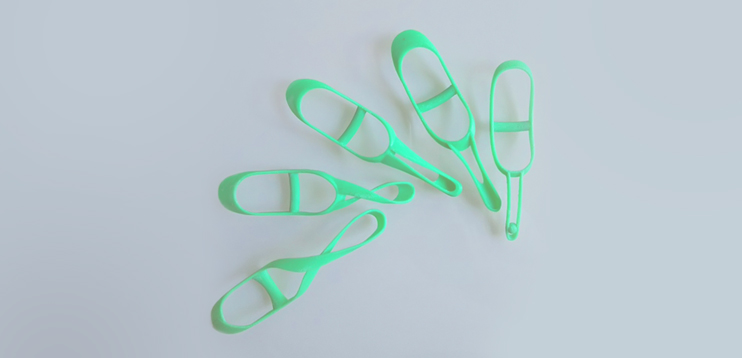
Iterations of Tatsuo Ishibashi’s assistive tool
“I make so many prototypes by my desktop 3D printer because I need them in order to get what satisfies both design and functional requirements,” he said. “3D printers are quite good tools for us because we can evaluate immediately whether our designs are functionary or not. I print out the final version of my products through Shapeways.”
From molecular engineering to 3D design
Although Ishibashi is well-versed in 3D design now, his original career path led him to molecular engineering. “I specialized in molecular engineering in graduate school. I learned programming and engineering there. And I experienced research and product development including design in a manufacturing company.” With that experience under his tool belt, he was able to take that knowledge and apply it to the complex world of 3D design.
Like any designer, however, Ishibashi has faced his fair share of obstacles. Because he’s self-taught, he struggled to find a test process that could measure both functionality and mechanical strength. Ishibashi then discovered the Fusion360 software and UPPlus2 printer which allowed him to measure both qualities, each vital to the design’s success. Once he had constructed solid models of his idea, he turned to his mentors for inspiration. “I learned from lecturers of specialized seminars and from visitors of exhibitions to which I submitted,” Ishibashi told Shapeways.
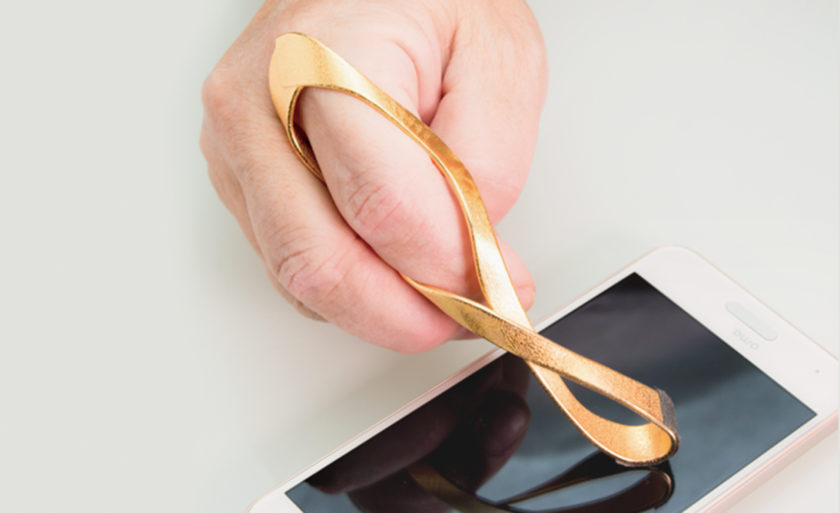
The “Touch assist holder” is a device for operating smartphone or tablet screens.
The future of assistive tools
Soon enough, Ishibashi was on his way to releasing his designs to the public, assisting the elderly and those with muscle weakness in a completely new way. His assistive tools were incredibly well received and in the future, he hopes to “upgrade the cutlery holder and change the design of the writing assist holder. I hope that a category of the self-help devices will grow steadily. Now I plan to conduct a verification test in some care homes in Japan.”
He adds, “Some of the visitors in the exhibition held in July [2018] had keen interests in my products, and had an idea of conducting a demonstration test in their facilities. I plan to offer the tests [in the near future]. My future image is that many 3D designers will participate in the assistive device field and communicate at the same platform with users.”

The post Tatsuo Ishibashi’s Vibrant Designs are Game-Changing Assistive Tools for People with Muscle Weakness appeared first on Shapeways Magazine.
Makelab partners with AMFG for automated 3D printing on-demand
Lego Battery #3DThursday #3DPrinting
Are you looking to power motors and servos with your LEGO builds? 3D print a battery case for LEGO robotics projects! This is 3D printed 8×8 LEGO compatible box that contains a 3xAA battery pack. The box is comprised of four pieces that snap-fit together. It features studs and tubes that can attach to either side of LEGO bricks.
Full tutorial learn guide:
https://learn.adafruit.com/lego-compatible-battery-case

Every Thursday is #3dthursday here at Adafruit! The DIY 3D printing community has passion and dedication for making solid objects from digital models. Recently, we have noticed electronics projects integrated with 3D printed enclosures, brackets, and sculptures, so each Thursday we celebrate and highlight these bold pioneers!
Have you considered building a 3D project around an Arduino or other microcontroller? How about printing a bracket to mount your Raspberry Pi to the back of your HD monitor? And don’t forget the countless LED projects that are possible when you are modeling your projects in 3D!
The Adafruit Learning System has dozens of great tools to get you well on your way to creating incredible works of engineering, interactive art, and design with your 3D printer! If you’ve made a cool project that combines 3D printing and electronics, be sure to let us know, and we’ll feature it here!





